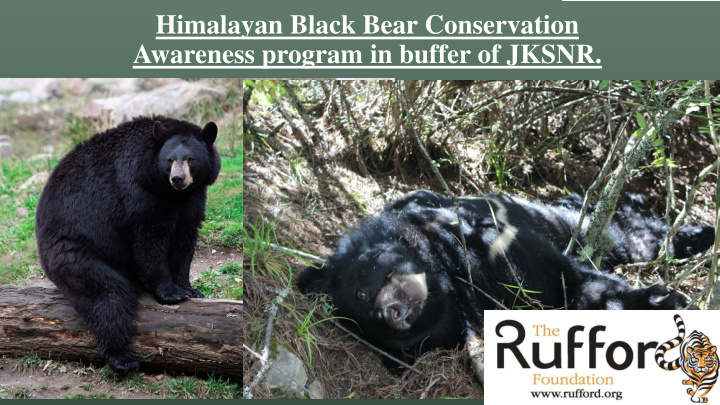



Himalayan Black Bear Conservation Awareness program in buffer of JKSNR.
HIMALAYAN BLACK BEAR • Asian black bears are dwelling in daytime , • though they become nocturnal near human habitations. • They may live in family groups consisting of two adults and two successive litters of young. • They are good climbers of rocks and trees, and will climb to feed, rest, sun, elude enemies and hibernate.
HIMALAYAN BLACK BEAR • Half of their life is spent in trees and they are one of the largest arboreal mammals. • Asian black bears break branches and twigs to place under themselves when feeding on trees, thus causing many trees in their home ranges to have nest-like structures on their tops.
HIMALAYAN BLACK BEAR DIET • HIMALAYAN BLACK BEAR ARE OMNIVEROUS
HIMALAYAN BLACK BEAR • HIBERNATION OF BEAR • MID OCTOBER TO MARCH
1. BREEDING SEASON OCCURS FROM MID JUNE TO MID AUGUST 2. BIRTH OCCURS IN MID JANUARY
The average lifespan in the wild = 25 years , Asian black bear in captivity died at the age of 44.
The Himalayan black bear is a violent animal, sometimes attacking without annoying, and inflicting horrible wounds, attacking generally the head and face with their claws, while using their teeth also on a prostrate victim. It is not uncommon to see men who have been terribly mutilated, some having the scalp torn from the head.
Legal status of Himalayan Black bear • It is totally Protected Species as per FNCR 2017 • Fine for killing bear = Nu.25000.00
Legal status of Himalayan Black bear Bile cost =Nu. 20000.00
Legal status of Himalayan Black bear Each Paws =Nu.5000.00
• Human-Bear Conflict • What are the conflicts faced by you all? • Do you know why Conflict? • (Harvesting of NTFPs, food of bears by people) • Any suggestions on the conflict management from your side?
Recommend
More recommend